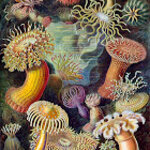Evolution

As I’m having a baby my mind has recently been turned to thoughts of the very weird and wonderful world of developmental biology. As a new parent tracks the progress of their child, you can’t help wonder about some of the really bizarre stages it goes through.
Some of the odd developments (gill slits and tails as examples) can be explained by the research of a 19/20th century German researcher, Ernst Haeckel. This eminent man was more than a scientist, he was a physician, philosopher, artist and teacher. Haeckel’s contribution to biology was immense, in addition to naming and identifying…

An interesting Economist article about sex differences in a visual task calls an evolutionary explanation a “just-so story.” I don’t know if the late Stephen Jay Gould, evolutionary theorist, Harvard professor, and “one of the most influential and widely-read writers of popular science of his generation” (Wikipedia), invented this form of dismissal, but certainly he was fond of it. Here, for example:
Evolutionary biology has been severely hampered by a speculative style of argument that . . . tries to construct historical or adaptive explanations for why this bone looked like that or why this…

It seems the evolution versus creationism debate will never end. Professor Steve Jones, a geneticist from University College London will address delegates at the 7th annual University College Dublin-Conway Festival of Research in O’Reilly Hall, University College Dublin on Thursday, September 20th 2007 about ‘Why evolution is right and creationism is wrong’.
Why hear an argument against something unproven at all? Jones is concerned that intelligent Design is being presented as scientific fact. Proponents of intelligent design state that the universe and everything in it has been designed by…

What killed the Neanderthals? No one can say for sure but an international study led by the University of Leeds has ruled out one of the popular recent theories, catastrophic climate change, as the most likely cause.
The bones of more than 400 Neanderthals have been found since the first discoveries were made in the early 19th century. The finds suggest the Neanderthals, named after the Neander Valley near Düsseldorf, where they were first recognized as an extinct kind of archaic humans, inhabited Europe and parts of western Asia for more than 100,000 years.
The causes of their extinction…

How we come to express the genes of one parent over the other is now better understood through studying the platypus and marsupial wallaby – and it doesn’t seem to have originated in association with sex chromosomes.
New research published in BMC Evolutionary Biology has shed light on the evolution of genomic imprinting, in which specific genes on chromosomes that have been inherited from one parent are expressed in an organism, while the same genes on the chromosome inherited from the other parent are repressed.
Imprinting arises from some kind of ‘epigenetic memory’ – modifications to the…

In evolutionary terms, the difference between 2.1 and 2.2 children is a lot more important than the small difference sounds, especially as it accumulates over time.
A new study in Royal Society Biology Letters says that achieving that maximum offspring count is best accomplished by men if their partner is approximately 6 years younger and by women if their partner is approximately 4 years older.
This means that a man may not just be interested in a trophy wife, he may be thinking about the future of humanity. But this happens with women also. Women who find a new mate still choose a…

Dating younger women is not just about trophy wives, say the researchers behind the PLoS paper, "Why Men Matter: Mating Patterns Drive Evolution of Human Lifespan." It's also about understaning evolution.
Male reproduction begins and ends later than women’s, and declines much more gradually. In many population a fraction of men continue to father children into their 60s and 70s with younger women.
In some groups, most notably Australian aboriginal and African polygynous societies, late-age male reproduction is common. In many hunter-gatherer societies, which may tell us most about how our…

Cooperation is widespread in the natural world but so too are cheats – mutants that do not contribute to the collective good but simply reap the benefits of others’ cooperative efforts. In evolutionary terms, cheats should indeed prosper, so how cooperation persists despite the threat of cheat takeover is a fundamental question. Recently, biologists at the Universities of Edinburgh and Oxford have found that in bacteria, cheats actually orchestrate their own downfall.
In the study, reported in the September issue of The American Naturalist, the team explored the impact of cheats in…

Natural selection has driven two closely related species of fish in Lake Malawi down different evolutionary paths - even though they live side by side.
An international team of scientists from Canada (Université Laval), the U.K. (University of Hull, Cardiff University) and Spain (Doòana Biological Station), have discovered that a pair of closely related species of East African cichlid fishes – a group of fish whose diversity comprising hundreds of species has puzzled evolutionary biologists for decades – evolved divergent immune gene adaptations which might explain why they do not interbreed…

Ancient footprints have provided compelling evidence that some dinosaurs were able to swim. The 15m (50ft) trackway was discovered in the Cameros Basin in Spain, which, 125 million years ago, in the Early Cretaceous was a vast lake.
The unusual-shaped prints suggest the animal clawed at sediment on the lake bottom as it swam in about 3m (10ft) of water. Though it has been suggested that large sauropods occasionally waded through shallow waters, it is thought that these tracks were left by a large, bipedal, carnivorous dinosaur that was not wading, but rather was using the water to support its…